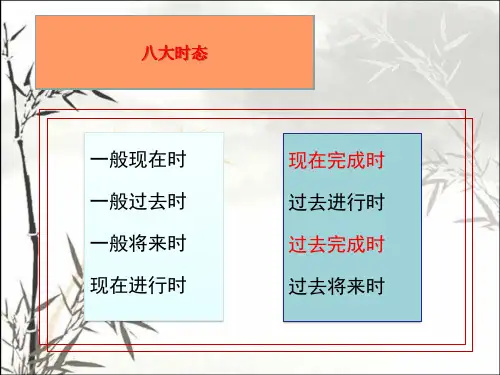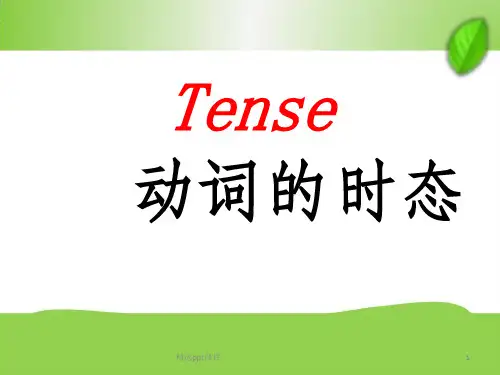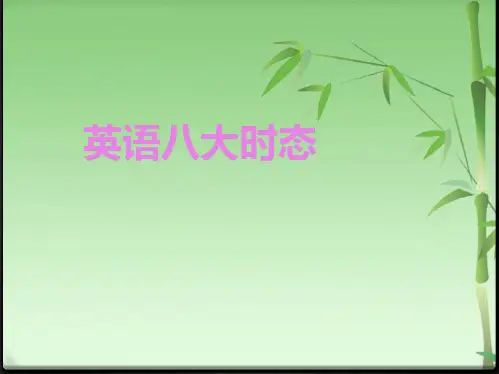英语八大时态PPT课件(详细版)
合集下载
八大时态 PPT课件

八大时态
一般现在时 一般过去时
现在完成时
过去进行时 过去完成时 过去将来时
一般将来时
现在进行时
一般现在时
表示经常性或习惯性的动作
表示现在的状态
表示普遍事实或真理
一般现在时结构
当主语不是第三人称单数时: 肯定句 :主语+动词原形+其它 否定句 :主语+don't+动词原形+其它 一般疑问句: Do+主语+动词原形+其它
I leave home for school at 7:00 every morning. She/He/It gets up at 6:00 every day.
一般过去时
表示过去某个时间发生的动作或存在的状态,长和表 示过去的时间状语连用 例如:yesterday,last night,in+过去的年份, two days ago,before,the age of,the day before yesterday等。 也表示过去经常或反复发生的动作,长和表示频度的 时间状语连用 例如:often,always,once a week
2)This is the… that…结构,that从句要用现在完成时. This is the best film that I've (ever) seen. 这是我看过的最好的电影。 This is the first time (that) I've heard him sing. 这是我第一次听他唱歌。
用于现在完成时的句型
1)It is the first / second time…. that…结构中的从句部分,用现在完 成时。 It is the first time that I have visited the city. It was the third time that the boy had been late.
一般现在时 一般过去时
现在完成时
过去进行时 过去完成时 过去将来时
一般将来时
现在进行时
一般现在时
表示经常性或习惯性的动作
表示现在的状态
表示普遍事实或真理
一般现在时结构
当主语不是第三人称单数时: 肯定句 :主语+动词原形+其它 否定句 :主语+don't+动词原形+其它 一般疑问句: Do+主语+动词原形+其它
I leave home for school at 7:00 every morning. She/He/It gets up at 6:00 every day.
一般过去时
表示过去某个时间发生的动作或存在的状态,长和表 示过去的时间状语连用 例如:yesterday,last night,in+过去的年份, two days ago,before,the age of,the day before yesterday等。 也表示过去经常或反复发生的动作,长和表示频度的 时间状语连用 例如:often,always,once a week
2)This is the… that…结构,that从句要用现在完成时. This is the best film that I've (ever) seen. 这是我看过的最好的电影。 This is the first time (that) I've heard him sing. 这是我第一次听他唱歌。
用于现在完成时的句型
1)It is the first / second time…. that…结构中的从句部分,用现在完 成时。 It is the first time that I have visited the city. It was the third time that the boy had been late.
英语时态8种基本时态讲解.ppt课件

4)动词过去式变化规则。 a)一般情况下的词加-ed. work---worked call----called b)以不发音的字母e结尾的单词直接加-d . live----lived change----changed smoke----smoked die----died graduate----graduated drive----drove
8.过去完成时 表示动作发生在过去某一时间之前已经完成的动作或状态, 强调“过去的过去”, 常与 by the time, by the end of…,before , by 等引导时间的状语连用。
基本结构 主语+ had + 动词过去分词 + 其他成分 When I got to the cinema yesterday the film had begun already. He had learned English before he came here.
现在完成时与一般过去时的区别: 1)现在完成时侧重于对现在的影响;而一般过去时侧重于某一动作发生在过去某个时间或某段时间。即现在完成时侧重于现在的结果,而一般过去时侧重于动作发生的时间。例如:
I have seen the film. 我看过这部电影。(现在我仍记得电影的内容) I saw the film three days ago. 三天前我看了这部电影。(强调是三天前,而不是别的什么时候看的电影)
be going to含有“打算,准备”的意思,而will则没有这个意思, She is going to lend us her book. He will be here in half an hour.
be about to+V.原形(意为马上做某事,在时间上指最近的将来) I am about to leave school. 不能与表示时间的副词连用。 They are about to set out.(√) They are about to set,变y为i加-ed. study----studied carry----carried cry----cried try----tried d)以元音字母+y结尾的单词直接加-ed. play----played stay----stayed
8.过去完成时 表示动作发生在过去某一时间之前已经完成的动作或状态, 强调“过去的过去”, 常与 by the time, by the end of…,before , by 等引导时间的状语连用。
基本结构 主语+ had + 动词过去分词 + 其他成分 When I got to the cinema yesterday the film had begun already. He had learned English before he came here.
现在完成时与一般过去时的区别: 1)现在完成时侧重于对现在的影响;而一般过去时侧重于某一动作发生在过去某个时间或某段时间。即现在完成时侧重于现在的结果,而一般过去时侧重于动作发生的时间。例如:
I have seen the film. 我看过这部电影。(现在我仍记得电影的内容) I saw the film three days ago. 三天前我看了这部电影。(强调是三天前,而不是别的什么时候看的电影)
be going to含有“打算,准备”的意思,而will则没有这个意思, She is going to lend us her book. He will be here in half an hour.
be about to+V.原形(意为马上做某事,在时间上指最近的将来) I am about to leave school. 不能与表示时间的副词连用。 They are about to set out.(√) They are about to set,变y为i加-ed. study----studied carry----carried cry----cried try----tried d)以元音字母+y结尾的单词直接加-ed. play----played stay----stayed
初中英语八大时态-讲解ppt课件

D.have;left
精选ppt课件
18
六、过去将来时
1.用法:从过去看将要发生的动作。
2.结构:would was/were/going to +v.(原型)
例题
1.--What did he say yesterday?
--He said he____to Sydney next week.
A.goes B.will go
在有关的过去动作用现在完成,与现在 无关的过去动作用一般过去。)
4.易错点:
1 have gone to+地点,表示“去了某地”。
(人已走,尚未回。只用于第三人称。)
They have gone to Europe.
(They are not here.)
精选ppt课件
22
2 have been to+地点,表示“去过某
C.would go D.are going
2.--Did your son fail his English exam once again?
--Yes, but he told me he____hard next term.
A.studies B.is studying C.wil--When____we have the meeting? ---At 8.
A.are B.shall
C.would D.will
4.--When___you___for London? --Next week.
A.will;leaving
B.are;leaving
C.shall;leave
A.are work
B.are worked
C.work
英语时态8种基本时态讲解最新PPT课件

? I saw the film three days ago.
? 三天前我看了这部电影。 (强调是 三天前,而不是别的什么时候看的 电影)
? 8.过去完成时
? 表示动作发生在过去某一时间之前 已经完成的动作或状态 , 强调 “过去的过去” , 常与 by the time, by the end of…,before , by 等引导时 间的状语连用。
? 现在完成时与一般过去时的区别:
? 1)现在完成时侧重于对现在的影响;而 一般过去时侧重于某一动作发生在过去 某个时间或某段时间。即现在完成时侧 重于现在的结果,而一般过去时侧重于 动作发生的时间。例如:
? I have seen the film.
? 我看过这部电影。 (现在我仍记得 电影的内容 )
? 注意: ? 一般现在时通常与 always , often ,
usually 等频度副词以及 every day , sometimes , once a week 等时间状 语连用。
? I always watch TV at 8:00 in the evening .
? They go home once a week .
英语8种基本时态讲解
?一.概念:英语中表示不同时 间发生的动作或存在的状态, 需用不同的动词形式表示,这 种不同的动词形式称为时态。
? 二.种类:(基本时态) ? 一般现在时 一般过去时 ? 现在进行时 过去进行时 ? 一般将来时 过去将来时 ? 现在完成时 过去完成时
1.一般现在时:
? 句型结构:主语+V.(包括be动词)+ 宾语+其他成分
? c)----He likes music. ? ----He doesn' t like music. ? ----Does he like music? ? ----Yes ,he does./ No, he doesn' t .
? 三天前我看了这部电影。 (强调是 三天前,而不是别的什么时候看的 电影)
? 8.过去完成时
? 表示动作发生在过去某一时间之前 已经完成的动作或状态 , 强调 “过去的过去” , 常与 by the time, by the end of…,before , by 等引导时 间的状语连用。
? 现在完成时与一般过去时的区别:
? 1)现在完成时侧重于对现在的影响;而 一般过去时侧重于某一动作发生在过去 某个时间或某段时间。即现在完成时侧 重于现在的结果,而一般过去时侧重于 动作发生的时间。例如:
? I have seen the film.
? 我看过这部电影。 (现在我仍记得 电影的内容 )
? 注意: ? 一般现在时通常与 always , often ,
usually 等频度副词以及 every day , sometimes , once a week 等时间状 语连用。
? I always watch TV at 8:00 in the evening .
? They go home once a week .
英语8种基本时态讲解
?一.概念:英语中表示不同时 间发生的动作或存在的状态, 需用不同的动词形式表示,这 种不同的动词形式称为时态。
? 二.种类:(基本时态) ? 一般现在时 一般过去时 ? 现在进行时 过去进行时 ? 一般将来时 过去将来时 ? 现在完成时 过去完成时
1.一般现在时:
? 句型结构:主语+V.(包括be动词)+ 宾语+其他成分
? c)----He likes music. ? ----He doesn' t like music. ? ----Does he like music? ? ----Yes ,he does./ No, he doesn' t .
八大时态讲解(共26张PPT)

He is going to buy her some flowers.
0 一般过去将来时:
He was sixty-eight. In two years he would be seventy.
I knew you would agree.
0 现在英进行语时的: 动词时态(进行) What are you doing?
算;
如:I am going to listen to music. (我打算听音乐) will /shall 表示未事先思考或为计划过的意图
如:It will be Christmas soon .(很快就圣诞节了)
4. 现在进行时态( The Present Continuous Tense )
5、我们离开广州六年了。
We have left Guangzhou for 6 years . ×
We have been away from Guangzhou for 6
years .
3.常见句型
1) 主句(现在完成时)+since 从句(一般过去时).
2) It is +一段时间+ since 从句(一般过去时).
has gone to
He said had seen this morning, …ago, etc
that he _________the film many 如果明天不下雨,我们将去野营。
He has borrowed the pen for three days .
times. 现在进行时态( The Present Continuous Tense )
was /were going to +动词原形
0 一般过去将来时:
He was sixty-eight. In two years he would be seventy.
I knew you would agree.
0 现在英进行语时的: 动词时态(进行) What are you doing?
算;
如:I am going to listen to music. (我打算听音乐) will /shall 表示未事先思考或为计划过的意图
如:It will be Christmas soon .(很快就圣诞节了)
4. 现在进行时态( The Present Continuous Tense )
5、我们离开广州六年了。
We have left Guangzhou for 6 years . ×
We have been away from Guangzhou for 6
years .
3.常见句型
1) 主句(现在完成时)+since 从句(一般过去时).
2) It is +一段时间+ since 从句(一般过去时).
has gone to
He said had seen this morning, …ago, etc
that he _________the film many 如果明天不下雨,我们将去野营。
He has borrowed the pen for three days .
times. 现在进行时态( The Present Continuous Tense )
was /were going to +动词原形
初中英语八大时态课件

典型例句
I have just finished my homework. 我刚刚完成了 我的作业。
She hasn’t seen the film yet. 她还没有看过这部电影 。
Have you ever been to Europe? 你曾经去过欧洲吗 ?
They haven’t had any success so far. 他们到目前 为止还没有任何成功。
典型例句
总结词:用来说明一般过去时的用法和形式。
详细描述:以下是一些典型例句,说明一般过 去时的用法和形式
I played tennis yesterday.(我昨天打网球了。)
They visited the museum last week.(他们 上周参观了博物馆。)
We went to the party last night.(我们昨晚 参加了聚会。)
用法
主要用于描述现在正在发生的事情,也可以用于描述最近一段时间内发生的事情 ,强调现在的情况或状态。
动词形式
基本形式
be动词+动词的现在分词
肯定式
am/is/are+动词的现在分词
否定式
am/is/are+not+动词的现在分词
疑问式
把be动词提前到句首,其他部分按 顺序排列
典型例句
I am studying English now.(我现在正在学习英 语。)
总结词
表示过去发生的动作对现在产生的影响或结果
详细描述
现在完成时是指动作发生在过去,但这个动作对现在产生了 一定的影响或结果。这个时态常与“已经”、“刚刚”等词 连用,强调的是现在的情况或结果。
动词形式
英语八大时态PPT课件(详细版)
b
15
He is a lazy man . He ____the dirty jeans every day.(2014 )
A. always wears B. always wearing C. always to wear D. is always wearing
You will know the truth after you ___him.(2013) A. see B. will see C. are seeing D.to see
b
16
三、一般过去时
1、构成 一般过去时用动词的过
去式表示。除系动词be的过去式 有人称和数的变化外,其他动词 的过去式无人称和数的变化。
b
17
2、用法
※表示过去已经发生的动作,现在 已经结束,常与相应的过去时间状 语连用。 Tom fell ill last night , and he had to stay at home.
【翻译】
我今年20岁,住在北京。 I am twenty years old this year , and I live in Beijing.
火车将在一个小时后(in an hour)出发(set off)。 The train sets off in an hour.
她每天都走路上学。 She walks to school every day. 或:She goes to school on foot every day.
If it doesn’t rain tomorrow,we’ll
go shopping.
பைடு நூலகம்
b
6
常与一般现在时连用的时间状语有:
often 经常
英语八大时态PPT课件(详细版)
come)
The perfect tense is formed by combining the presentation
particles of the verb with have or has (e.g., he has gone, she has come)
The Composition of the Eight Tenses in English
03
Examples
I have studied, They have played, He has written
Present simple tense
Definition
The present simple tense is used to express an action that is verbal, generic, or not emphasizing time
VS
Tense can be classified into two categories: simple tense and complex tense Simple tense includes present, past, and future tense, while complex tense includes the perfect, the superior, the future perfect, and the conditional perfect tense
Conditional Perfect Tense
It is used to express actions or events that would have been completed in the past if a condition had been met
The perfect tense is formed by combining the presentation
particles of the verb with have or has (e.g., he has gone, she has come)
The Composition of the Eight Tenses in English
03
Examples
I have studied, They have played, He has written
Present simple tense
Definition
The present simple tense is used to express an action that is verbal, generic, or not emphasizing time
VS
Tense can be classified into two categories: simple tense and complex tense Simple tense includes present, past, and future tense, while complex tense includes the perfect, the superior, the future perfect, and the conditional perfect tense
Conditional Perfect Tense
It is used to express actions or events that would have been completed in the past if a condition had been met
初中英语八种时态归纳PPT
10. About 400 years ago, Galileo proved that the earth travels (travel) around the sun.
Part B 语态
Active Voice
Passive Voice
主动语态
1. Many people speak English.
At the party.
--- I _l_ik_e___ your jacket, Tim. How long _h_a_v_e_y_o_u__h_a_d__ it?
Oh…er… I __b_o_u_g_h_t__it last week. W__o_u_l_d_y_o_u__li_k_e_ to dance, Becky? ---Phew. It’s __h_o_t__ here. --- Put your jacket on the chair. You ____n_e_e_d_n’wt orry. It’ll be ok. ---That’s _b_e_tt_e_r __.
8. Mr. Green and his wife had lived (live) in London for a few years before they came (come) to work in China in 2001.
9. He said he w__o_u_ld__n_o_t_s_p_e_a(k not,speak) at the meeting the next day.
4. Hurry! Your classmates _a_r_e_w__a_it_i_n_g(wait) for you in the classroom..
1. This is the third time you _h_a_v_e__b_e_e_n__(be) here.
Part B 语态
Active Voice
Passive Voice
主动语态
1. Many people speak English.
At the party.
--- I _l_ik_e___ your jacket, Tim. How long _h_a_v_e_y_o_u__h_a_d__ it?
Oh…er… I __b_o_u_g_h_t__it last week. W__o_u_l_d_y_o_u__li_k_e_ to dance, Becky? ---Phew. It’s __h_o_t__ here. --- Put your jacket on the chair. You ____n_e_e_d_n’wt orry. It’ll be ok. ---That’s _b_e_tt_e_r __.
8. Mr. Green and his wife had lived (live) in London for a few years before they came (come) to work in China in 2001.
9. He said he w__o_u_ld__n_o_t_s_p_e_a(k not,speak) at the meeting the next day.
4. Hurry! Your classmates _a_r_e_w__a_it_i_n_g(wait) for you in the classroom..
1. This is the third time you _h_a_v_e__b_e_e_n__(be) here.
初中英语八大时态课件(共77张PPT)
exercise
把下列句子改为一般疑问句
1.He has a meeting on Sundays . Does he have a meeting on Sundays ?
2.He goes to school at seven in the morning . Does he go to school at seven in the morning?
2. 当 主 语 是 单 数 第 三 人 称 时 , 它与助动词Does有关,但是 动词谓语一定要恢复为原形。 当主语是其他人称时,它与 助动词Do有关。
I like English. She likes it very much. We go to work by bike.
否定句
I don’t like English.
3.My father and mother go out for lunch on Sundays. Do your father and mother go out for lunch on Sundays ?
4.We do our homework after school.
Do you do your homework after school ?
2) I will return home as soon as I finish my task.
2、be going to + v原形
①表示打算做某事 ②表示现在已经有迹象表明将要发生某事。
--- What __a_re__y_o_u__g_o_in_g__t_o_do this evening? --- I am going to do my lessons.
Review of Tenses
- 1、下载文档前请自行甄别文档内容的完整性,平台不提供额外的编辑、内容补充、找答案等附加服务。
- 2、"仅部分预览"的文档,不可在线预览部分如存在完整性等问题,可反馈申请退款(可完整预览的文档不适用该条件!)。
- 3、如文档侵犯您的权益,请联系客服反馈,我们会尽快为您处理(人工客服工作时间:9:00-18:30)。
※表示主语所具有的特征、性格、 能力、状态等 She is a middle school student. She looks a little worried. ※某些以here/there开头的句子 中,用一般现在时表正发生的动 作 Here comes the bus.
5
※表示将来发生的、时刻表上不改变的事 The train leaves Hunan at five o’clock. ※特殊情况 在时间状语从句和条件状语从句中,若主 句用一般将来时,则从句用一般现在代替 将来。(主将从现) I’ll see you when I get there.
2
1、构成 一般现在时常用动词原
形,但第三人称单数作主语时, 动词的词尾要加s或es
3
2、用法
※表示经常性、习惯性的动作 I go to the park once a week.
When do you usually have breakfast?
※表示客观真理 The sun rises in the east. 4
时态
知识导航
种类
一般现在时 一般过去时 一般将来时 现在进行时 现在完成时 过去进行时 过去完成时 过去将来时
构成
do/does did will/shall+动词原形 am/is/are + doing have/has+过去分词 was/were + doing had+过去分词 would/should+动词原 形
If it doesn’t rain tomorrow,we’ll
go shopping.
6
常与一般现在时连用的时间状语有:
often 经常
usuallry day 每天
sometimes 有时
seldom 几乎不
always 总是
once a week一周一次
7
【翻译】
14
The man ____ with his parents once a year.
(2014 )
A.goes travel
B. goes traveling
C. is going travel D.is going traveling
She is doing her homework while her mother ____ to her.(2014 ) A. speaks B. spoke C.to speak D. speaking
15
He is a lazy man . He ____the dirty jeans every day.(2014 ) A. always wears B. always wearing C. always to wear D. is always wearing
You will know the truth after you ___him.(2013) A. see B. will see C. are seeing D.to see
11
常与现在进行时连用的时间状语有:
now 现在
right now 现在
these days 这些天 at this moment在此刻
12
【翻译】
我认为他正在看电视。 I think (that)he is watching TV. 当我在睡觉的时候他正在听音乐。 While I am sleeping , he is listening to music.
13
Look! there____ our dog.(2013 ) A. come B. comes C. to come D. coming
Look ! The sun ___ , and it ___from the west.(2013) A. falls down , falls down B. falls down , falling down C. is falling down , falls down D. is falling down , falling down
10
※有些动词(arrive,come,go,leave) 的ing形式可表示将发生的、计划或 安排好的事。 We are leaving here next week. She is coming to see me tomorrow.
※while后常用doing形式 While you are reading the book , he is sleeping.
8
1、构成 现在进行时由“助动词be
(am/is/are) + doing”构成。
9
2、用法
※表此时此刻正发生的动作,常与 now连用。 They are cleaning the room. Listen , someone is shouting. ※与副词always连用,表达一种感情 色彩。 She is always thinking of others instead of herself. Why are you always coming late?
我今年20岁,住在北京。 I am twenty years old this year , and I live in Beijing.
火车将在一个小时后(in an hour)出发(set off)。 The train sets off in an hour.
她每天都走路上学。 She walks to school every day. 或:She goes to school on foot every day.
※追述逝去的人或事。 Edison was a great inventor.
18
※表示过去经常或反复发生的动作, 可与always, usually, often, sometimes, never 连用。 He usually walked to school last year.
16
1、构成 一般过去时用动词的过
去式表示。除系动词be的过去式 有人称和数的变化外,其他动词 的过去式无人称和数的变化。
17
2、用法
※表示过去已经发生的动作,现在 已经结束,常与相应的过去时间状 语连用。 Tom fell ill last night , and he had to stay at home.
